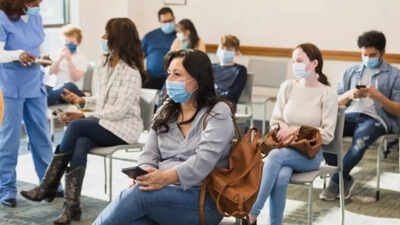ARTICLE AD BOX

Image credits: Getty Images
The COVID-19 pandemic was definitely one of the worst times to have plagued humanity. Millions of people lost their lives to a disease whose origin and ideal treatment remain an enigma even today.
Like any other difficulty, humans adapted and figured out solutions for survival.While treatment for the virus is available, being infected with it is a gruesome journey that many fail to survive. According to an estimate by the Centers for Disease Control and Prevention (CDC), 25 states are seeing a growth in the number of COVID cases as the summer wave appears to be starting, reported CBS News. While the activity remains "low" nationwide based on the CDC wastewater data, it has upgraded from "very low" from the previous week.
Which states have the maximum number of cases?

Image credits: Getty Images
Some of the highest increases in emergency rooms for COVID have happened in the Pacific Northwest and the Southeast. While the former has seen a steep rise in ER visits in June, the latter has been gradually rising for weeks.Due to new variants spreading across the states, health officials are expecting a rise in COVID-19 cases this summer. COVID-19 cases are growing in these states, as per the CDC:ArkansasHawaiiIllinoisIowaKentuckyNorth CarolinaOhioPennsylvaniaTexasVirginiaAdditionally, the cases are likely growing in these locations:AlaskaCaliforniaDelawareDistrict Of ColumbiaGeorgiaIndianaMaineMarylandMassachusettsMichiganMississippiNew JerseyNew YorkOklahomaSouth CarolinaTennesseeWisconsin
Which COVID-19 variants are spreading in the US?

Image credits: Getty Images
As per a recent CDC analysis, COVID seems to be following a twice-a-year pattern, where cases pick up once in the summer (July through September) and once in the winter (December through February).
“Our analysis revealed biannual COVID-19 peaks in late summer and winter, a pattern that is expected to persist as long as the rapid evolution of SARS-CoV-2 and cyclical S1 diversity continues,” CDC scientists wrote.SI diversity is the ongoing changes in a key part of the virus's spike protein, which helps it bind to human cells.The latest COVID variants spreading in the US include Nimbus and Stratus. While these are new, they are "no more deadly" than the previous variants, according to CBS News chief medical correspondent Dr Jon LaPook.
The symptoms also match in terms of respiratory problems such as cough and sore throat, and systemic issues like fever and fatigue.The center also warned about another virus spreading more rapidly recently, the Parvovirus B19. People who get infected don't get very sick but experience flu-like symptoms such as fever, muscle aches and a rash.Chicago, in particular, has seen a spike in patients visiting the ER due to this virus. “Several of the most recent weeks saw the highest percentage of B19-associated ED visits compared to the same week in all years since 2015,” health officials said. Pregnant women are at a higher risk for complications from the virus and thus are advised to wear masks when going to high-risk areas.



.png)
.png)
.png)
















 7 hours ago
7
7 hours ago
7







 English (US) ·
English (US) ·